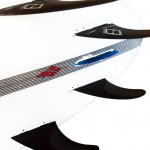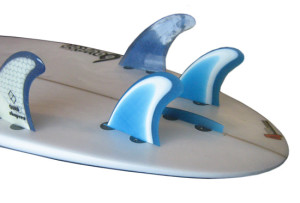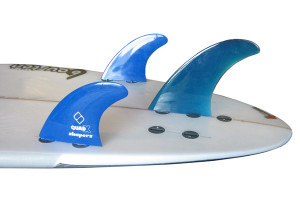Innovation is the creation of better or more effective ideas. Innovation differs from invention in that innovation refers to the use of a new idea or method, whereas invention refers more directly to the creation of the idea or method itself.
————————————————————————————————————-
The Mini Keels
 “Stretch and drive. It’s is amazing what a little fin can do. Muzza gave me the stabiliser to try out in one of my 5’8” Quads and it added a new element. Quad’s are faster than thrusters but lack I tiny bit of control. This little fin seems to bring that back with out loosing the speed. It a great fin to add to a board when the swell kicks a bit. 3ft plus, it also allows you to get a little bit more drive and run in your bottom turns. I’ve noticed Kelly Slater has been rocking a similar fin in his Quad setups too. Enjoy”
“Stretch and drive. It’s is amazing what a little fin can do. Muzza gave me the stabiliser to try out in one of my 5’8” Quads and it added a new element. Quad’s are faster than thrusters but lack I tiny bit of control. This little fin seems to bring that back with out loosing the speed. It a great fin to add to a board when the swell kicks a bit. 3ft plus, it also allows you to get a little bit more drive and run in your bottom turns. I’ve noticed Kelly Slater has been rocking a similar fin in his Quad setups too. Enjoy”
Brooko
MORE : About the Mini Keels Here
————————————————————————————————-
The Combo
I guess being older and not as strong a paddler as I once was, is in part responsible for my lean toward quads, due to their wider nose that allows me to paddle better but still keeping short. Quads have more east west freedom than thrusters because for one of a few reasons the rear fins are further up from the tail and clustered closer to the front fins. This is not possible with a centre thruster fin because it will slide out under pressure whereas with the quad the rear fins are out closer to the rail and therefore have more grip at high speeds.

I have taken quads to a new level in the last year or two and have found myself in a quad bubble, albeit happy but again finding it difficult going back to a thruster design mainly because of their poor paddle attributes. Again a new design has formed due to my in abilities. I needed to keep area forward without the thruster feeling front heavy. It became pretty obvious the only way was to move the centre fin forward and make it larger so as to not lose grip. So the board did not feel to finny (too much surface area in the fins) the front side fins needed to be reduced in size in order to balance up.
In fact I have designed a tri fin (not as if it has not been done before) but the most exciting thing for me is that really I have married a quad and thruster design into one board where there is literally no compromise in either.
If the versatility of the quads I have designed wasn’t enough now with a tri fin combo the board has yet another functional personality.
 At first I was going to make a board called the combo but I realized this fin combination could be applied to all my wider nosed quads. I have specifically used fcs plugs for the 2 main reasons. Firstly there would be too much rigidity in the tail if it was a future type system and there also would be to many empty boxes trapping water flow in every application. At least with fcs it is only a couple of small slits.
At first I was going to make a board called the combo but I realized this fin combination could be applied to all my wider nosed quads. I have specifically used fcs plugs for the 2 main reasons. Firstly there would be too much rigidity in the tail if it was a future type system and there also would be to many empty boxes trapping water flow in every application. At least with fcs it is only a couple of small slits.
1. The quads needs little explanation since I have been expounding their benefits the last 4 years. When the waves are hollow with long walls the quad set up is going to be totally at home
2. In heavier waves where the wider tail of a quad may restrict a powerful stab off the bottom the mini keel gives added bight and punch. The Carroll brothers always maintain that a vee out the tail of a quad gives you some semblance of center (a feeling obviously missing in a quad) which I have agreed with (all my quads have tail vees ,some longer, some shorter) and the small blade emphasizes this feel and adds to the bight and ping off the bottom. This is not really recommended in small waves because it is not needed. The 3 center plugs allow you to position the keel slightly behind the rear quad fins encouraging you further back for increased pivot. It could be advisable to use smaller rear quads with the blade particularly if the waves are not so big, if you still like the feel.
3. The Tri fin application when you think it through makes complete sense to this design. The position normally surfed with a quad is forward because the back fins are more forward – than a thruster. If you surf a combo quad and thruster you tend to get lost when changing over because the thruster needs to be surfed off the tail. Not so with the tri because the center fin is up the same distance from the tail as the rear quads so when converting you surf from the same position but with a different reaction. Obviously the center fin needs to be deeper as it has to anchor more width as it is further forward. The front fins are in the same position so in effect the cluster is tighter producing shorter arcs and enabling a wider nose to be whipped around easier.
By reducing the influence of the front side fins by making them smaller (we use the rear side quads and put them in the front side position) the center fin becomes the dominant fin and the drive is gained by the sheer size (single fin feel) of this fin and the fact that the front sides are diminished in size, so too is their influence. By this I mean they will not grab the face of the wave with such power that they could force the center fin to slide out . The optimum time to convert to the tri would be when the waves are more peaky and more vertical surfing is required or when the surf is so unpredictable that you need a lightening pivitol type response.
4 To surf wider nose boards as a thruster- to escape the front heavy feel, the board needs to be shorter or the waves need to be almost too big for the board so it has a looser feel. I have used 3 center plugs in the combo system for one – a thruster choice, using the rear 2 plugs, secondly, also using the same position- for the mini blades so they sit a little behind the rear quads. It is worth knowing that when moving a center fin from the rear 2 plugs to the front 2 plugs, the move is 2 inches, which is considerable when it comes to fin positioning speak.
In conclusion the combo system is I believe almost a “quiver buster”.
The fact is these boards paddle above their length due to extra width and wider noses. In addition their capacity to cling to the face at high speeds and sit high and deep in the barrel when in quad mode ,suggests there are not many types of waves they are not ready for .If more vert is required in fat peaky waves the tri mode ticks all the boxes and in small waves their width particularly in the tail makes them feel totally at home as well.
It is really not in my interest to kill the concept of the quiver but over the years I have hated having to lug surfboard coffins all over the world in order to be prepared for whatever waves may come my way .Nor do I like to be caught out with the wrong board when the waves are on. Now I reckon 2 boards in a tight little cover will almost do me since I am not chasing a wildcard for the “Eddie”.
Airlines are getting more aggressive with price when faced with the back breaking coffins. Even the pros who have clung to the concept of the fixed fin for years are abandoning this in droves due to this pressure, where now nearly 80% are using a fin system. I think the combo is a design application of the time ,for the time.
Muzz
———————————————–
“Hey Jimmy theory is since the centre fin has been moved up further from the
tail than normal it should be bigger and this you might expect would
stiffen the board but the fact that it is clustered closer to the front side
fins (because they are where they would normally be) the board has more
east- west as a result . Ideally for a guy your size in med sized surf I
would go 7’s in the centre rear and 1000’s in the front or even GX’s if you
want even more pivot and vert.
Muzz”
———————————————————-
Your spot on. When in tri-fin I go a 7 centre and 1000’s in the wings. It
works great when the waves are more sucky and take-offs late, but you
certainly notice the lost of mid face drive and speed.
Nothing beats testing hey!!
James Atkinson
———————————————————-
Hey Murray .
I have had a couple of surfs using the tri fin set up instead of the quad & I am really impressed.
In smaller peakier waves it really lets you get off the top & too the top much easier . Lacks a bit of thrust down the line but you can wack the quads back in when that’s needed, still a great change , Its like having 2 boards in 1.
Good work !
Thanks Blair
——————————————————-
Hey Muzz,
i really like the tri-fin mode. and it has just slightly less drive than in quad mode. definitely goes more vertical and bottom turns more sharply.
Sincerely,
Victor Flores
————————————————————-
You got to hand it to muz with the round tails,not only do they look great they surf even better!!!!! This tri-fin test I did was an excellent learning curve for me, to see how a board performed so large(a 6 inch) and so far up from the tail(5 inches) and with these little 1000’s on the side. And a razor fine/sharp carbon fibre tail for added stiffen est and bite!!! So I have had this tri-fin since winter time and you can ride it as a quad but just love the tri, this thing can hold off the bottom hard! Tight! And at hi-speed. So what ever you do off the bottom you should do off the top, right, hard, tight, arcs that amazingly sharp, while holding maximum speed. Top-to-bottom surfing is a pleasure, while drawing and fading thru sections of the wave is done with confidence, cause of the 6″ center fin and super fine tail that gives grip that is enforced by a carbon tail. One of the hi-lights is the trotter fin system. This fin system is able to let the surfer move the fins forward and back. I used the 6″ fin about half forward(5″) and the side fins at 11″ at 4 foot Lennox point(fore hand) and foot Ragland(backhand) . If in bigger surf I would move the fin forward to maximum forward. In smaller junkie surf, I used a normal thruster set-up with all 3 fins (g-am) at 3 3/8 center fin and 11 with the sides, and had the same feeling of a normal short board with a spiral-vee making it run easy to rail to rail. So in bigger surf the 6″ fin moved forward center and 2 smaller outrigger style fins is going to make it awesome to use in the more powerful surf. In the junk use your favorite thruster set-up. Virtually you have 2 boards in one. Big waves big center fin, small waves use smaller fins. And then you still have the quad set-up, but I haven’t got there yet cause I still am in love with the tri. So I will tell you later about the foursome later. Thanks Dan.
——————————————————-
Hi Murray,
I have been trying out your tri fin set up for the past week and half which included surfs at Straddie, Main Beach, Coolie and Angourie point on both my fat and silver bullets. My overall impression of the tri fin set up is:
1. The board dosen’t have the same instant acceleration as it has set up as a quad. Good top end speed is able to be generated but requires more pumping than a quad.
2. I did not have alot of trouble swapping from one set up to the other so I think your theory regarding foot placement is pretty correct.
3. The tri fin set up certainly allows you to do a full bottom turn to set up vertical top hand turns, though at first I found I was turning a little late getting to the top of the wave.
4. The tri fin set up works well when trying to get barrelled, it make the board easier to set up an S bottom turn and easier to stall for a tube.
Overall I think the set up is functional and would be a good option when the waves are peaky and you want to pull off a couple of reos or vertical snaps. Personally after trying both my boards as quads, thrusters and tri fin set ups I have say I still prefer quads because it is just easier to pick up speed, my cutties and carving turns are much better on a quad and you get used to doing top hand turns on a quad if you surf them all the time.
Regards,
Glen.